IRP Interns Shine at Summer Poster Day
Upon entering the sunny foyer of the NIH’s Natcher Conference Center last Thursday, I was immediately struck by a burst of loud, excited chatter. As it always is on NIH’s annual Summer Poster Day, the building was filled with hundreds of high school and college students and the scientists, families, and friends who had turned out to see what these young men and women had spent the summer doing.
This year, over a thousand NIH summer interns presented posters detailing the results of their time in IRP labs during NIH’s Summer Internship Program. Some posters were dense with text laying out complex imaging, sequencing, and other techniques, while others were neatly arranged with a few graphs and bullets summarizing key takeaways. No matter what form the posters took, it was hard not to come away impressed by the hard work this year’s interns had put into their scientific pursuits.
In case you couldn’t make it out to the event, here’s a taste of the budding scientific acumen that was on display.
Ishu Sivakumar: Sussing Out the Secrets of Sickle Cell Disease
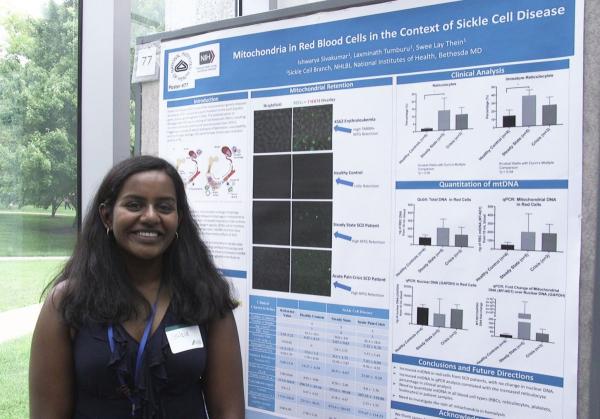
A rising junior at Johns Hopkins University in Baltimore, Maryland, Ishu spent her summer examining cellular energy producers called mitochondria in patients with sickle cell disease. The condition, which causes malformed red blood cells that cannot carry much oxygen, leads to inflammation throughout the body that can trigger painful episodes called crises. Ishu’s experiments revealed that patients with sickle cell disease have more mitochondrial DNA in their red blood cells, suggesting that an increased concentration of mitochondria might play a role in the ailment’s symptoms.
“I think I’ve become very confident now in explaining mechanisms, in actually working in a lab, in presenting, so I think it was a great experience,” she says of her time at NIH. “I’m pre-med, so I don’t plan on going into research in the future, but this program has made me think strongly about it. It’s made me consider research as a career. As somebody who did not want to do research before, I really think it’s a possibility for me now.”
Riley Driscoll: Assessing Aging’s Effect on Skeletal Muscle
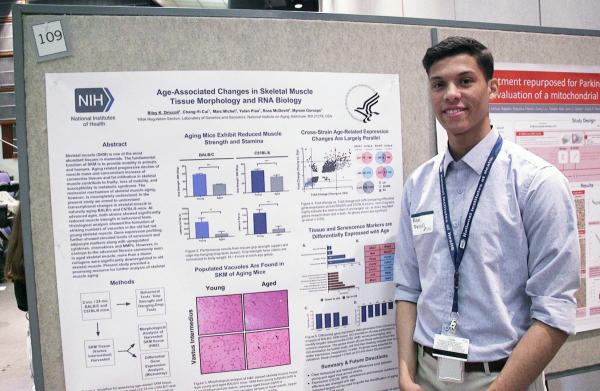
Riley knew exactly what he wanted to do after graduating this spring from Brigham Young University in Provo, Utah. For the third time in his college career, he spent his summer examining the biological effects of aging, this time focusing on how it changes the structure and function of skeletal muscle, as well as the activity of genes within it.
“Skeletal muscle is really important for mobility, generating body heat, and resistance to injury,” he explains. “As we age, we start to see muscle mass and muscle strength go down, so we wanted to get a better understanding of the changes that happen in skeletal muscle tissue with age.” This work could provide insights into the mechanisms that cause a decline in muscle mass over time, as well as point to markers of aging that clinicians and scientists can use to gauge muscle deterioration.
“If I’ve come back to NIH this many times, it’s obviously been really great,” Riley says of his experience here. “There’s a lot of freedom and a lot of space to contribute intellectually, and that’s one of the things I’ve liked about the lab I’ve been working in. My PI encourages her interns and fellows to go in their own directions and seek out what they think is interesting.”
Jennifer Zhu: Gazing into the Eye of the Ground Squirrel
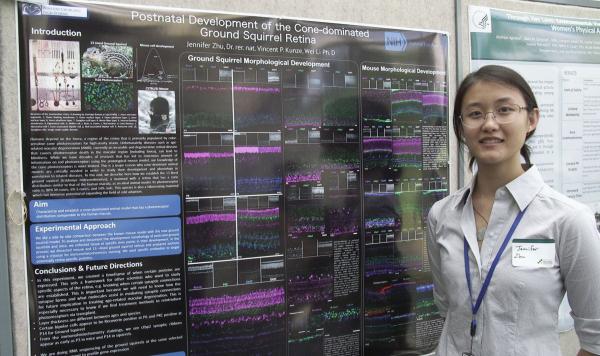
Before darting off to her freshman year at Wellesley College in Boston, Massachusetts, Jennifer made a pit stop at the NIH to peer into the eyes of the 13-lined ground squirrel. The retina in the eye contains two types of light detectors, called rods and cones, and ground squirrels have many more cones in their retinas than rods. Scientists have long studied mice to glean insights into human eye diseases, but because they’re nocturnal, their retinas contain a much higher concentration of rods than cones. Studying the development and structure of the cone-heavy ground squirrel retina can provide scientists with a model organism better suited to shedding light on human ailments that result from the deterioration of cones, which drastically reduces patients’ visual acuity.
“The people I’ve been working with in my lab have all been so nice and welcoming,” Jennifer says. “I’ve learned so many different techniques and been exposed to so many new experiences. I feel like this has really bolstered my résumé as a person who is interested in science and medicine.”
Katy Werwath: Searching for Brain Structure Differences in Generalized Anxiety
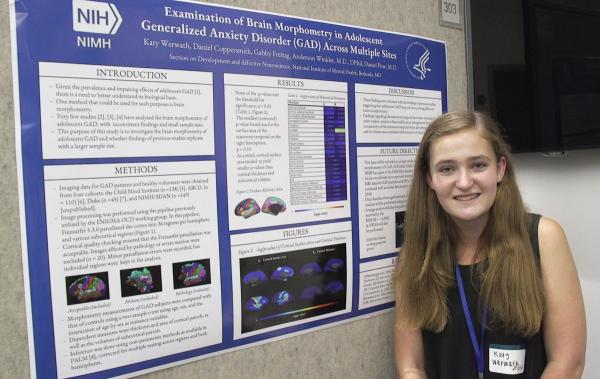
Katy, a rising senior at Maggie L. Walker High School in Richmond, Virginia, has been busy snapping pictures of the brains of healthy individuals and patients with generalized anxiety disorder. Detecting differences in these images would help to illuminate the underlying biology of anxiety disorders; unfortunately, like prior studies, Katy’s analysis could not detect any significant distinctions between the two sets of brains. Fortunately for her, even science that fails to produce results can be incredibly valuable.
“Working on this project was amazing,” she says. “Everyone was so nice and welcoming. I didn’t have much experience in this area before I came here, but everyone really took the time to teach me about everything.”
Alexis Ayuketah: Examining Eating Behavior When Consuming Processed Food
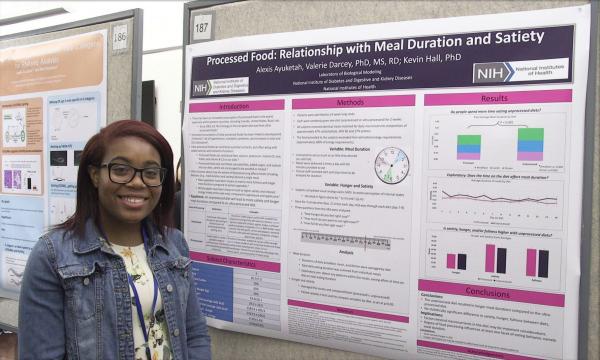
Ahead of her junior year at Eleanor Roosevelt High School in Greenbelt, Maryland, Alexis came to NIH to analyze data from a study assessing how long participants took to consume meals of unprocessed foods like broccoli, rice, and steak compared to highly processed fare like cheeseburgers and pancakes. She ultimately found people ate the unprocessed food more slowly than the processed food. Since it takes considerable time for the stomach to tell the brain it’s full, this sort of information about eating behavior could explain why people eat more when their meals are made up of processed foods.
“Growing up, I was very confused about what I wanted to be,” Alexis says. “This experience gave me another area to look into. I didn’t really care much about nutrition at the beginning, I wanted to be a neurosurgeon, but now I’m wondering if I really want to be a neurosurgeon or if I want to be a researcher or a physician. This has given me a great look into all the different areas of science I could go into.”
William Cusma: Scrutinizing Stress’s Influence on the Brain

As a rising senior pre-med student at Loyola University Maryland in Baltimore, William is no stranger to stress. Scientists have long known that stress has a substantial impact on the functioning of the human brain, and William used electrophysiological techniques to measure how stress alters neuronal firing in a brain pathway important for experiencing reward. His work revealed that stress increases the firing of reward-related neurons in a brain structure called the dorsal raphe nucleus, which could have the counter-intuitive effect of decreasing a person’s ability to experience reward.
“If you’re talking to somebody, just because they’re talking louder or quicker, that doesn’t mean you’re understanding them any better,” he explains. “We think these neurons at the beginning of the pathway are speaking faster in response to stress, and the neurons at the end of the pathway are pulling away because the earlier ones are talking too much.” Learning more about how stress affects this pathway could lead to more effective therapies for ailments like depression and substance abuse that are often triggered by stress.
“When I came in I didn’t know much about electrophysiology,” William says. “I got to learn so much and got to meet a lot of great people, make some connections, make some friends. I definitely expect to be back.”
Whether focusing on hyperactive neurons, deteriorating muscles, or empty stomachs, a summer internship in the IRP is a truly unique undertaking. These six interns and the multitude of others that devoted their summers to science will return to school or embark on the next stage of their careers with invaluable knowledge about the day-to-day pleasures and frustrations of performing biomedical research. I hope they are departing even more enthusiastic about science and medicine than when they arrived.
Related Blog Posts
This page was last updated on Wednesday, July 5, 2023
